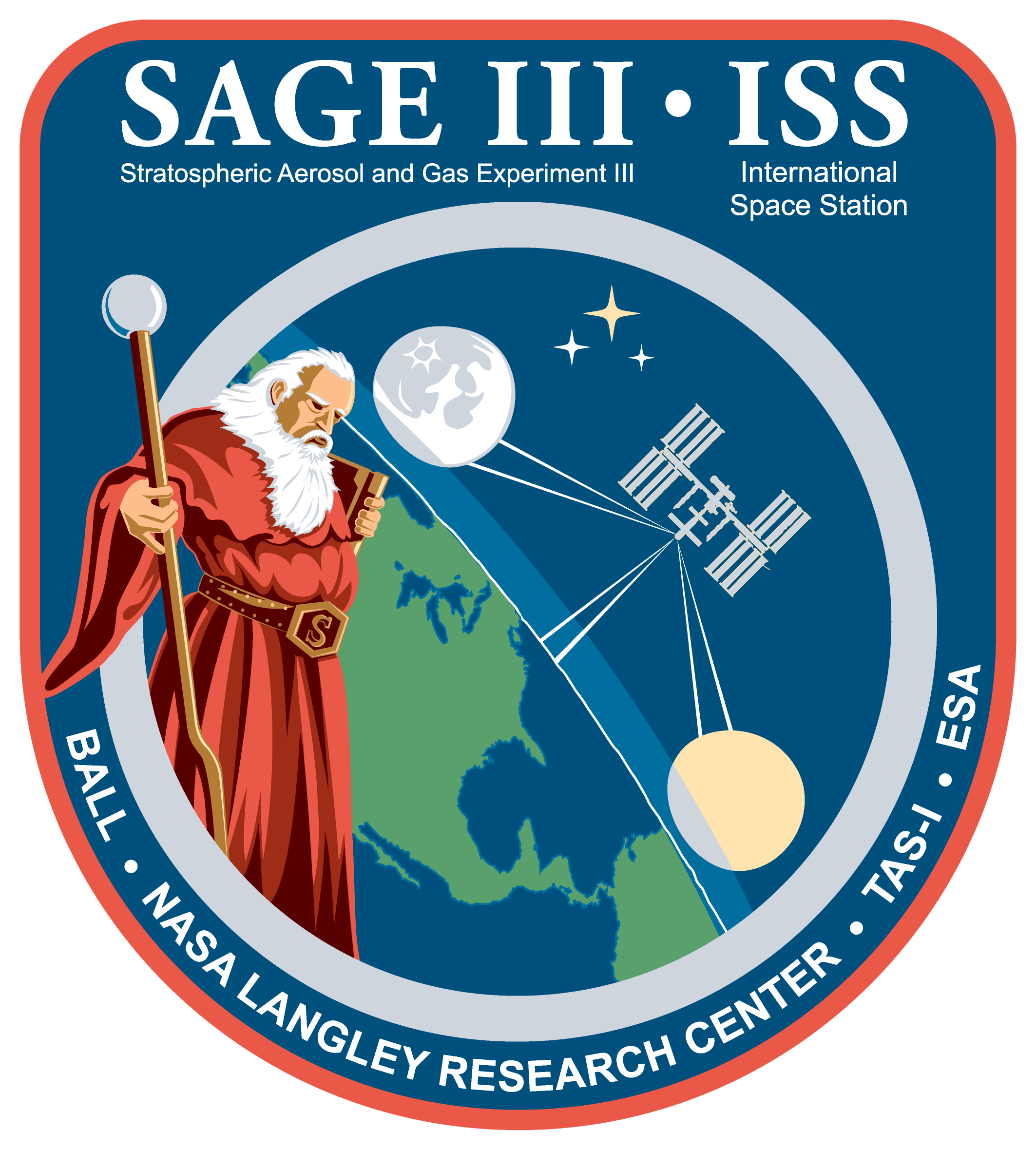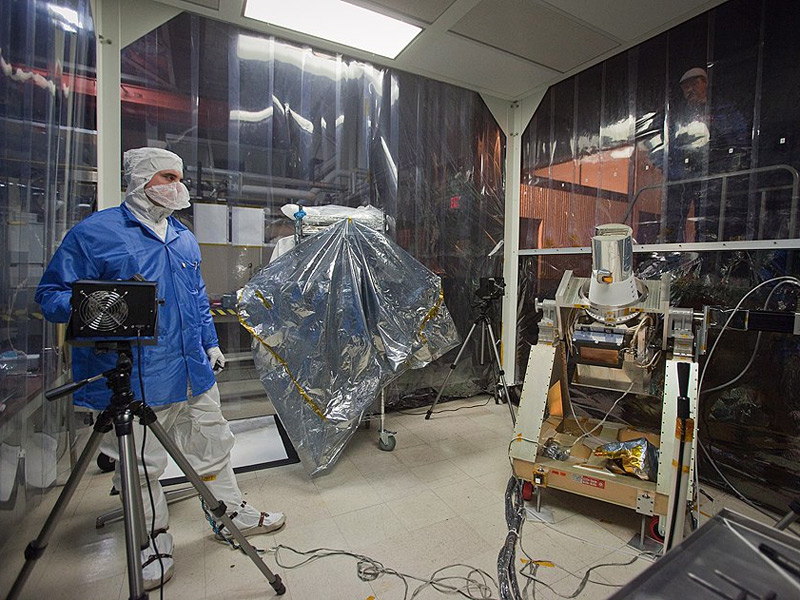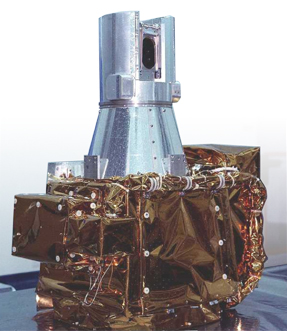SAGE III on ISS on:
[Wikipedia]
[Google]
[Amazon]
 SAGE III on ISS is the fourth generation of a series of
SAGE III on ISS is the fourth generation of a series of

 The SAGE III mission is an important part of NASA's Earth Observation System and is designed to fulfill the primary scientific objective of obtaining high quality, global measurements of key components of atmospheric composition and their long-term variability. The primary focus of SAGE III on ISS will be to study aerosols, clouds, water vapor, pressure and temperature, nitrogen dioxide, nitrogen trioxide, and
The SAGE III mission is an important part of NASA's Earth Observation System and is designed to fulfill the primary scientific objective of obtaining high quality, global measurements of key components of atmospheric composition and their long-term variability. The primary focus of SAGE III on ISS will be to study aerosols, clouds, water vapor, pressure and temperature, nitrogen dioxide, nitrogen trioxide, and
 Ozone research has remained at the forefront of atmospheric science for many years because stratospheric ozone shields the Earth's surface (and its inhabitants) from harmful ultraviolet radiation. Since recent declines in stratospheric ozone have been linked to human activity, accurate long-term measurements of ozone remain crucial.
It is important to monitor ozone levels in the lower stratosphere and upper troposphere since observed trends are the largest and most poorly understood at those altitudes. SAGE III's high vertical resolution and long-term stability make it uniquely well suited to make these measurements. SAGE III is also able to look at the relationship between aerosol, cloud, and chemical processes affecting ozone argue for simultaneous measurements of these atmospheric constituents (such as those made by SAGE III).
Ozone research has remained at the forefront of atmospheric science for many years because stratospheric ozone shields the Earth's surface (and its inhabitants) from harmful ultraviolet radiation. Since recent declines in stratospheric ozone have been linked to human activity, accurate long-term measurements of ozone remain crucial.
It is important to monitor ozone levels in the lower stratosphere and upper troposphere since observed trends are the largest and most poorly understood at those altitudes. SAGE III's high vertical resolution and long-term stability make it uniquely well suited to make these measurements. SAGE III is also able to look at the relationship between aerosol, cloud, and chemical processes affecting ozone argue for simultaneous measurements of these atmospheric constituents (such as those made by SAGE III).
 SAGE III was launched on the
SAGE III was launched on the
NASA.gov
NASA.gov
SAGE III on ISS
at NASA.gov
by Langley Research Center
International Space Station experiments Satellite meteorology Aerosol measurement
 SAGE III on ISS is the fourth generation of a series of
SAGE III on ISS is the fourth generation of a series of NASA
The National Aeronautics and Space Administration (NASA ) is an independent agencies of the United States government, independent agency of the US federal government responsible for the civil List of government space agencies, space program ...
Earth-observing instruments, known as the Stratospheric Aerosol and Gas Experiment. The first SAGE III instrument was launched on a Russian Meteor-3M satellite. The recently revised SAGE III was mounted to the International Space Station
The International Space Station (ISS) is the largest modular space station currently in low Earth orbit. It is a multinational collaborative project involving five participating space agencies: NASA (United States), Roscosmos (Russia), JAXA ( ...
where it uses the unique vantage point of ISS to make long-term measurements of ozone
Ozone (), or trioxygen, is an inorganic molecule with the chemical formula . It is a pale blue gas with a distinctively pungent smell. It is an allotrope of oxygen that is much less stable than the diatomic allotrope , breaking down in the lo ...
, aerosols, water vapor
(99.9839 °C)
, -
, Boiling point
,
, -
, specific gas constant
, 461.5 J/( kg·K)
, -
, Heat of vaporization
, 2.27 MJ/kg
, -
, Heat capacity
, 1.864 kJ/(kg·K)
Water vapor, water vapour or aqueous vapor is the gaseous p ...
, and other gases in Earth's atmosphere
The atmosphere of Earth is the layer of gases, known collectively as air, retained by Earth's gravity that surrounds the planet and forms its planetary atmosphere. The atmosphere of Earth protects life on Earth by creating pressure allowing fo ...
.
History of the SAGE legacy
The first SAGE instrument was launched on 18 February 1979, to collect data on the various gases in the atmosphere, including ozone. The data collected on SAGE I and the following instrument SAGE II, which began taking measurements in October 1984, were critical to the discovery of the Earth'sozone hole
Ozone depletion consists of two related events observed since the late 1970s: a steady lowering of about four percent in the total amount of ozone in Earth's atmosphere, and a much larger springtime decrease in stratospheric ozone (the ozone lay ...
and the creation of 1987 Montreal Protocol
The Montreal Protocol is an international treaty designed to protect the ozone layer by phasing out the production of numerous substances that are responsible for ozone depletion. It was agreed on 16 September 1987, and entered into force o ...
, which banned ozone-depleting substances, such as chlorofluorocarbon
Chlorofluorocarbons (CFCs) and hydrochlorofluorocarbons (HCFCs) are fully or partly halogenated hydrocarbons that contain carbon (C), hydrogen (H), chlorine (Cl), and fluorine (F), produced as volatile derivatives of methane, ethane, and pro ...
(CFC).
SAGE III on ISS is a nearly exact replica of SAGE III, on Meteor-3M, sent into orbit in 2001 on a Russian satellite. SAGE III on Meteor-3M went out of service in March 2006 when the satellite's power supply stopped working. The new instrument was built in anticipation of being attached to the space station in 2005. A change in ISS design, however, put those plans on hold. The instrument was stored in a Class 100 clean room in a sealed shipping container under a continuous gaseous nitrogen purge. The purge kept clean dry "air" inside the instrument.
Recently, the opportunity arose for SAGE III to be placed on ISS, and build on the long record of stratospheric gas data that its ancestors created. The week of 14 February 2011, scientists at NASA Langley Research Center pulled the instrument from storage to begin initial testing and calibrations in preparation prepping it for launch.

Science behind SAGE III on ISS
The SAGE III instrument is a gratingspectrometer
A spectrometer () is a scientific instrument used to separate and measure spectral components of a physical phenomenon. Spectrometer is a broad term often used to describe instruments that measure a continuous variable of a phenomenon where the ...
that measures ultraviolet and visible energy. It relies upon the flight-proven designs used in the Stratospheric Aerosol Measurement (SAM I) and first and second SAGE instruments. The SAGE III design incorporates charge-coupled device
A charge-coupled device (CCD) is an integrated circuit containing an array of linked, or coupled, capacitors. Under the control of an external circuit, each capacitor can transfer its electric charge to a neighboring capacitor. CCD sensors are a ...
(CCD) array detectors and a 16 bit A/D converter. Combined, these devices allow for wavelength calibration, a self-consistent determination of the viewing geometry, lunar occultation measurements, and expanded wavelength coverage.
The SAGE III sensor assembly consists of pointing and imaging subsystems and a UV/visible spectrometer. The pointing and imaging systems are employed to acquire light from either the Sun or Moon by vertically scanning across the object. The spectrometer uses an 800 element CCD linear array to provide continuous spectral coverage between 290 and 1030 nm. Additional aerosol information is provided by a discrete photodiode at 1550 nm. This configuration enables SAGE III to make multiple measurements of absorption features of target gaseous species and multi-wavelength measurements of broadband extinction by aerosols.
Atmospheric components studied by SAGE III on ISS
 The SAGE III mission is an important part of NASA's Earth Observation System and is designed to fulfill the primary scientific objective of obtaining high quality, global measurements of key components of atmospheric composition and their long-term variability. The primary focus of SAGE III on ISS will be to study aerosols, clouds, water vapor, pressure and temperature, nitrogen dioxide, nitrogen trioxide, and
The SAGE III mission is an important part of NASA's Earth Observation System and is designed to fulfill the primary scientific objective of obtaining high quality, global measurements of key components of atmospheric composition and their long-term variability. The primary focus of SAGE III on ISS will be to study aerosols, clouds, water vapor, pressure and temperature, nitrogen dioxide, nitrogen trioxide, and chlorine dioxide
Chlorine dioxide is a chemical compound with the formula ClO2 that exists as yellowish-green gas above 11 °C, a reddish-brown liquid between 11 °C and −59 °C, and as bright orange crystals below −59 °C. It is usually ...
.
Aerosols
Aerosols play an essential role in the radiative and chemical processes that govern the Earth's climate. Since stratospheric aerosol loading has varied by a factor of 30 since 1979, long-term monitoring of tropospheric and stratospheric aerosols is crucial. SAGE III aerosol measurements will provide important contributions in the area of aerosol research.Clouds
Clouds play a major role in determining the planet's solar and longwave energy balance and, thus, are important in governing the Earth'sclimate
Climate is the long-term weather pattern in an area, typically averaged over 30 years. More rigorously, it is the mean and variability of meteorological variables over a time spanning from months to millions of years. Some of the meteorologi ...
. SAGE III will provide measurements of mid and high level clouds including thin or "sub-visual" clouds that are not detectable by nadir-viewing passive remote sensors. These observations are important because while low clouds primarily reflect incoming solar radiation back into space (acting to cool the planet), mid and high level clouds enhance the "greenhouse effect
The greenhouse effect is a process that occurs when energy from a planet's host star goes through the planet's atmosphere and heats the planet's surface, but greenhouse gases in the atmosphere prevent some of the heat from returning directly ...
" by trapping infrared radiation
Infrared (IR), sometimes called infrared light, is electromagnetic radiation (EMR) with wavelengths longer than those of visible light. It is therefore invisible to the human eye. IR is generally understood to encompass wavelengths from around ...
(acting to warm the planet). Also, the presence of thin cloud near the tropopause
The tropopause is the atmospheric boundary that demarcates the troposphere from the stratosphere; which are two of the five layers of the atmosphere of Earth. The tropopause is a thermodynamic gradient-stratification layer, that marks the end of ...
may play a significant role in heterogeneous chemical processes that lead to ozone destruction in mid-latitudes.
Water vapor
Water vapor is the dominant greenhouse gas and plays a crucial role in regulating the global climate system. An improved understanding of the global water vapor distribution can enhance our ability to understand water's role in climate processes. SAGE III water vapor measurements will provide important contributions on the long-term effect of this green house gas.Ozone
 Ozone research has remained at the forefront of atmospheric science for many years because stratospheric ozone shields the Earth's surface (and its inhabitants) from harmful ultraviolet radiation. Since recent declines in stratospheric ozone have been linked to human activity, accurate long-term measurements of ozone remain crucial.
It is important to monitor ozone levels in the lower stratosphere and upper troposphere since observed trends are the largest and most poorly understood at those altitudes. SAGE III's high vertical resolution and long-term stability make it uniquely well suited to make these measurements. SAGE III is also able to look at the relationship between aerosol, cloud, and chemical processes affecting ozone argue for simultaneous measurements of these atmospheric constituents (such as those made by SAGE III).
Ozone research has remained at the forefront of atmospheric science for many years because stratospheric ozone shields the Earth's surface (and its inhabitants) from harmful ultraviolet radiation. Since recent declines in stratospheric ozone have been linked to human activity, accurate long-term measurements of ozone remain crucial.
It is important to monitor ozone levels in the lower stratosphere and upper troposphere since observed trends are the largest and most poorly understood at those altitudes. SAGE III's high vertical resolution and long-term stability make it uniquely well suited to make these measurements. SAGE III is also able to look at the relationship between aerosol, cloud, and chemical processes affecting ozone argue for simultaneous measurements of these atmospheric constituents (such as those made by SAGE III).
Pressure and temperature
SAGE III temperature measurements will provide a unique data set for monitoring and understanding atmospheric temperature changes. In particular, the long-term stability and self-calibration capabilities of SAGE III may permit the detection of trends in stratospheric and mesospheric temperature that will be important diagnostics of climate change. SAGE III temperature measurements in the upper stratosphere and mesosphere will be a new source of long-term temperature measurements in this region of the atmosphere to complement existing long-term measurements made by satellites (MLS, ACE, SABER) and ground based lidar systems. SAGE III temperature measurements will also allow the monitoring of periodic temperature changes, such as those associated with the solar cycle and quasi-biennial oscillation, and the effects of radiative forcing by aerosols.Nitrogen dioxide, nitrogen trioxide, and chlorine dioxide
Nitrogen dioxide
Nitrogen dioxide is a chemical compound with the formula . It is one of several nitrogen oxides. is an intermediate in the industrial synthesis of nitric acid, millions of tons of which are produced each year for use primarily in the productio ...
(NO2), nitrogen trioxide (NO3), and chlorine dioxide
Chlorine dioxide is a chemical compound with the formula ClO2 that exists as yellowish-green gas above 11 °C, a reddish-brown liquid between 11 °C and −59 °C, and as bright orange crystals below −59 °C. It is usually ...
(OClO) play crucial roles in stratospheric chemistry and the catalytic cycles that destroy stratospheric ozone. SAGE III nitrogen dioxide measurements are important because the processes that occur in the Antarctic winter and spring and give rise to the ozone hole effectively convert NO2 to nitric acid (HNO3). Thus NO2 is an important diagnostic of ozone hole chemistry. Since it is measured during both solar and lunar occultation events, SAGE III observations of NO2 will improve our understanding of the strong diurnal (daily) cycles in stratospheric processes. In addition, SAGE III will make virtually unique measurements of nitrogen trioxide (NO3). Although it is short-lived in the presence of sunlight, NO3 plays an active role in the chemistry of other reactive nitrogen species such as NO2 and di-nitrogen pentoxide (N2O5) and, thus, indirectly in ozone chemistry. Since few other measurements of NO3 are available, SAGE III measurements, which are made during lunar occultation (nighttime) events, will provide crucial validation for our current understanding of reactive nitrogen chemistry.
Launch
 SAGE III was launched on the
SAGE III was launched on the SpaceX CRS-10
SpaceX CRS-10, also known as SpX-10, was a Dragon Commercial Resupply Service mission to the International Space Station (ISS) which launched on 19 February 2017. The mission was contracted by NASA as part of its Commercial Resupply Services pr ...
mission using a Falcon 9
Falcon 9 is a partially reusable medium lift launch vehicle that can carry cargo and crew into Earth orbit, produced by American aerospace company SpaceX.
The rocket has two stages. The first (booster) stage carries the second stage and pay ...
with Dragon. SAGE III traveled in the unpressurized trunk of Dragon, which launched on 19 February 2017. Upon arrival, NASA used Dextre
Dextre, also known as the Special Purpose Dexterous Manipulator (SPDM), is a two armed robot, or telemanipulator, which is part of the Mobile Servicing System on the International Space Station (ISS), and does repairs that would otherwise r ...
to berth the instrument onto an ExPRESS Logistics Carrier platform on the ISS.
International partners
NASA Langley Research Center, based out of Hampton, Virginia, is leading the SAGE III mission. Ball Aerospace & Technologies Corp. built the SAGE III-ISS instrument in Boulder, Colorado, and the European Space Agency (ESA) and Thales Alenia Space-Italy
Italy ( it, Italia ), officially the Italian Republic, ) or the Republic of Italy, is a country in Southern Europe. It is located in the middle of the Mediterranean Sea, and its territory largely coincides with the homonymous geographical ...
(TAS-I), headquartered in France
France (), officially the French Republic ( ), is a country primarily located in Western Europe. It also comprises of overseas regions and territories in the Americas and the Atlantic, Pacific and Indian Oceans. Its metropolitan area ...
, are providing a hexapod to keep the instrument pointing in the right direction as the ISS maneuvers in space.
Notes
{{Reflist, 30emReferences
NASA.gov
NASA.gov
External links
SAGE III on ISS
at NASA.gov
by Langley Research Center
International Space Station experiments Satellite meteorology Aerosol measurement